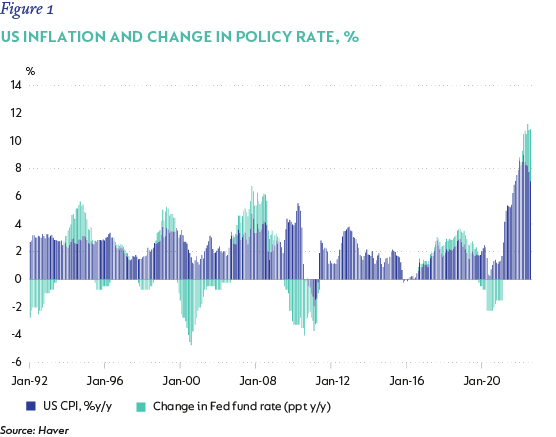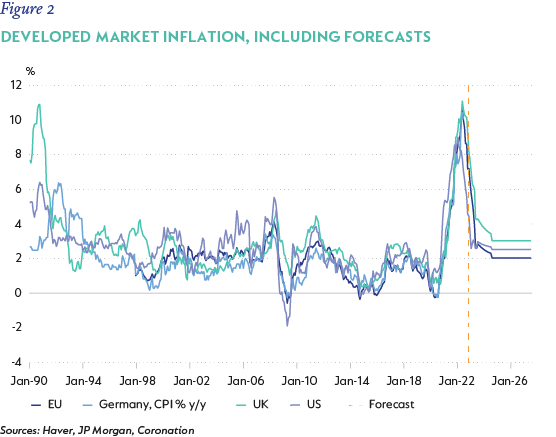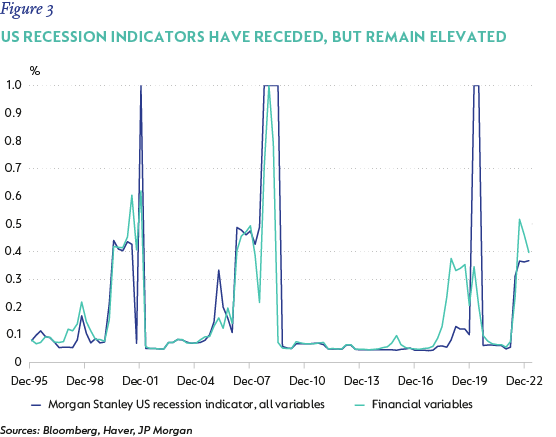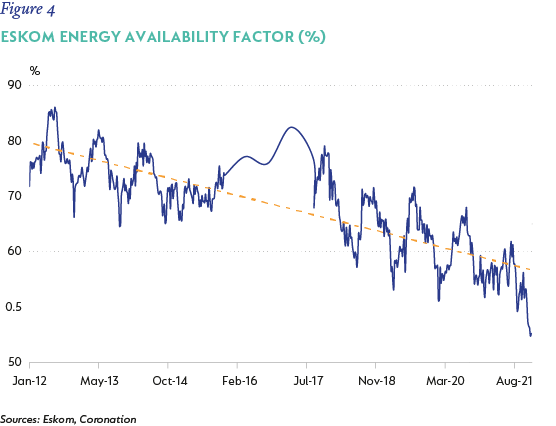
Economic views
The evolving crises of 2022 will shape 2023
“When written in Chinese, the word ‘crisis’ is composed of two characters. One represents danger and the other represents opportunity.” – John F. Kennedy
The Quick Take
- The full consequences of the unprecedented stack-up of negative events in 2022 are yet to play out in 2023
- Globally, recession remains a grave concern as central banks struggle to find their balance between taming inflation and protecting growth
- While SA was less scathed by macro events than many nations, it is beset with its own relentless challenges
- Economic recovery and the political agenda are interwoven; all eyes are on decisive action and long-term developments in the ANC
GOODBYE TO A RELENTLESS 2022
Last year was a year of many significant events. Individually, some of these were not as severe as past crises, but, as these converged, there were times when it felt as though everything that could go wrong, did. The Financial Times has used the word ‘polycrisis’ as a descriptor for 2022’s ‘overlapping and interwoven’ crises. While the year started with a global inflation problem, the Russian invasion of Ukraine compounded this into a crisis. This then prompted the largest, most coordinated tightening of monetary policy in four decades. The ensuing tightening of financial conditions saw asset prices fall, and markets and households suffer a relentless loss of value and incomes. The complex economic and political outcomes of these events are still evolving, and, while they remain incomplete, they will have significant implications for the economics and politics of the year ahead.
INFLATION WAS ALREADY A PROBLEM
Inflation was already a known global challenge at the start of 2022. This was the result of a succession of supply and demand shocks, starting with the pandemic economic lockdowns and the subsequent, disjointed reopening in 2020. The consequent supply chain disruptions that clashed with pent up demand and large stockpiled savings saw goods price pressures start to build into early 2021. The initial miscalculation of these pressures as ‘transitory’ by central banks meant that monetary policy settings remained too loose, and price pressure spread through goods and into global services. By January 2022, US headline consumer inflation was running at 7.5% year on year (y/y) from 1.4% y/y the previous year. In the EU, this figure was 6.% y/y from 0.1% y/y. And, from the start of the year, developed markets’ inflation outcomes started to meaningfully surprise to the upside of expectations.
This caused central banks to not only start raising interest rates, but to continue doing so (while initiating balance sheet management strategies in tandem) in the most relentless and coordinated fashion since the 1970s.
Taken together, the concurrent rise in inflation and policy rates (Figure 1) has placed incredible pressure on the spending systems of global economies, and this process is not yet over.

THE RUSSIAN INVASION OF UKRAINE TRIGGERED ITS OWN SET OF CRISES
At the end of February Russia invaded Ukraine. This, by itself, triggered a series of ‘polycrises’:
- The impact on commodity prices in general, but energy and food especially, created a simultaneous and reinforcing global inflation shock.
- The war hit Europe particularly hard. Not only was it the traumatic invasion of a sovereign state on European soil, but the interrelated impact of proximity to the war and the influx of Ukrainian refugees, economic integration, dependence on Russian oil and gas, and political repercussions including combined and coordinated sanctions and the resultant weaponisation of Russian energy against Europe, all mean the challenges facing Europe are intense, complex and, indeed, ongoing.
- From a geopolitical perspective, the Ukrainian invasion has strengthened relations within the North Atlantic Treaty Organisation (NATO), bringing the alliance closer than it has been in decades, and cementing a commitment by European members to increase military spending, while remaining committed to assisting Ukraine’s war efforts. While this strengthened alliance offers a stronger bulwark of global industrial cooperation and reenforced security structures, it also further isolates Russia and its associates, which carries immense risk into the new year.
CHINA’S ZERO-COVID POLICY EXACERBATED THESE TRENDS
Lastly, China persisted with its zero-Covid policy throughout 2022, successively locking down large cities, restricting domestic and international travel, and perpetuating the supply constraints affecting global inflation. Premier Xi Jinping’s verbal commitment to Russia and its implicit condoning of the invasion of Ukraine further strained China’s relations with the US and has raised concern that long-held ambitions of integrating Taiwan into China may be brought forward.
At the end of 2022, after Premier Jinping’s re-election as leader of the Chinese Communist Party, China abruptly ended its zero-Covid policy and materially reduced testing and restrictions on movement. The initial impact has been a huge spike in Covid infections and reports of a considerable loss of life owing in part to limited vaccine coverage and in part to low herd immunity. However, it seems likely that as mobility normalises, so too will business and consumer activity, and economic growth will rebound. In turn, the spike in demand could see commodity prices rise again, with implications for global inflation in the coming year.
Again, however, this is an incomplete process, and uncertainty related to timing and the outlook for China’s critical property sector remain highly uncertain.
SOUTH AFRICA WEATHERED THE STORM – MOSTLY
South Africa (SA) by and large escaped the inflation shock incurred by the majority of developed and emerging markets in 2022, buoyed by a positive terms of trade shock and a relatively resilient currency. Nonetheless, headline CPI spiked to 7.8% in July from 5.7% y/y in January, pushed up by rising fuel and food inflation, as well as a range of other goods and services prices. In line, core price pressures broadened through the year. Moderating fuel prices have seen headline pressures ease, but both measures of consumer inflation remain well above the South African Reserve Bank’s (the SARB) preferred target of 4.5%.
As elsewhere, the SARB was alert to the rise in consumer inflation, and – rather earlier than its developed market peers – started a relatively aggressive policy normalisation cycle. By the end of 2022, the Monetary Policy Committee raised the repo rate by a cumulative 350 basis points (bps), doubling the nominal rate from its low point of 3.5% to 7%.
While this is somewhat positive, SA did not escape unscathed and suffered its own blend of a political and economic polycrisis. The falling availability and reliability of electricity from the crumbling infrastructure of State-owned Eskom averaged 56% in 2022, leading to 208 days of loadshedding – the most severe outages South African’s have ever experienced. The economic cost of loadshedding, which increases exponentially as the ‘stage’ (intensity in consecutive lost hours) increases, is estimated at between 1% and 1.5% for the year; but it was more severe in the third quarter of 2022 (Q3-22), with the SARB estimating a growth drag of 2.4%.
In addition, urban water supply, in part owing to interrupted energy supply and in part reflecting poor maintenance, has also come under pressure; while flood-damaged transport infrastructure is no longer functioning at capacity, and has also faced escalating breakdowns. The political willingness and the ability to deal effectively with these enormous economic constraints has yet to become convincingly evident.
The ruling African National Congress headed into a contested election in December. While incumbent President Cyril Ramaphosa was re-elected and, ultimately, emerged with an executive, including the ‘Top Seven’, more closely allied to him than in the previous election, divisions in the party remain clear. During the election process shifting allegiances made outcomes much more uncertain.
SA’s economic challenges remain concentrated in the ability of the State to enable the economy to generate sufficient growth to tackle its own myriad of issues, with poverty, inequality, and fiscal sustainability chief amongst them. These challenges are also ongoing.
WELCOME 2023?
These unfinished events will continue to shape 2023
Aggregate inflation seems to have peaked, but the critical question for the year ahead is the path by which inflation will return to the target ranges of central banks. Here expectations vary. On balance, developed market central banks slowed the pace of rate hikes at the close of 2022, but also signaled that while inflation remains so high, their job is far from done. Figure 2 shows that until inflation is clearly reigned in, it is likely that interest rates will continue to rise and then restrictive stances be maintained, keeping pressure on spending systems until the pace of price formation slows meaningfully.

Recession indicators remain mixed. The successive policy interventions and economic shocks initiated in the past few years are now squeezing developed economies into an increasingly constrained position, as cash-strapped households see a slowdown in consumer demand. The result is that investment and manufacturing are also starting to slow. Overheated property markets are showing signs of cooling in the US and the UK, where mortgage rates have spiked to levels not seen since the financial crisis. Property activity has therefore slowed.
That said, available data doesn’t all suggest that large, developed economies are responding sufficiently to tighter policy stances for inflation to fall to target. In the US, the all-important labour market remains tight and wage pressure is concomitantly still elevated. Profitability has been solid, suggesting that labour retrenchment is still some way off, although recent data suggests a more pronounced slowing in growth is coming. The Federal Reserve Board (the Fed) is likely to slow the pace of tightening to 25bps increments in 2023, but has signaled that it will continue hiking the policy rate to 5% or beyond, until inflation and its drivers see pressure ease.
The outlook for the European Central Bank (ECB) is also challenging, but for different reasons. Inflation remains very elevated because of the impact of energy prices (now about five times higher than it was pre-Covid) on the headline. As this subsides, assisted by unravelling global bottlenecks, reduced global goods demand and prices, and more moderate wage formation in Europe, the ECB should be able to slow the pace of hiking too, although to a lower level than the Fed.
But it is going to be a difficult, if not impossible, balance for central banks to reign inflation back deliberately and decisively into range without moving into an uncertain ‘restrictive’ stance, without risking a meaningful and painful impact on economic activity. This process will be complicated by mixed data showing unexpected resilience in Europe and more recent weakness in the US.
Recessions in Europe, the UK and possibly the US are still a risk 2023 (Figure 3). While these will undoubtedly be painful, it’s important to highlight that the recessionary conditions should differ from the so-called ‘balance sheet recessions’ induced by the Global Financial Crisis. What we are likely to see is a shorter, sharper downturn, but that is more responsive to an ultimate easing in policy settings.

The short-term outlook for China is very uncertain. The recent policy shift should see the broad reopening put an end to the stop-start of repeated lockdowns. However, this was preceded by an unhappy period of elevated infection as the relatively low immunity rises. Thereafter, probably in the second half of 2023 (H2-23), a combination of improved mobility, the possibility of some easing in housing market restrictions and a recovery in the property market, alongside better general consumer spending should offset the impact of weaker exports. Current forecasts suggest a consensus real GDP forecast of about a 9% annualised rate at that time and growth of about 5% for the year.
South Africa’s economic political nexus continues
SA’s economic outlook is hostage to the increasingly inextricable link between politics and growth. Energy availability looks likely to remain deeply constrained through to the second quarter of 2023, as units of the two newer coal-fired stations remain offline, and the nuclear generator at Koeberg is being upgraded/refurbished (Figure 4). The persistent risk of breakage, unplanned maintenance and various acts of sabotage are expected to be ongoing and loadshedding at high stages is expected to continue. Growth in the first half of this year will struggle to exceed 1.% in real terms.

Despite current constraints, legislation passed late last year offers some hope. Gazetted changes to the Electricity Regulation Act (4 of 2006) provides for the exemption from applying for an electricity generation licence for all facilities, irrespective of capacity, and the licensing threshold has been abolished. New generation investment registrations at the National Energy Regulator of South Africa have risen meaningfully. We expect economy-wide non-Eskom energy availability to improve in H2-23 as some early self-generation projects reach completion. This won’t improve loadshedding but should shelter some of the productive areas of the economy from its effects. Eskom’s Energy Availability Factor should benefit from the return to service of some generation units that are currently offline for precautionary reasons in the second half of 2023, but, overall, we expect the system to remain highly constrained.
Transport infrastructure and efficiencies are an ongoing concern, as Transnet’s network of rail and port apparatus is still suffering from flood damage, sabotage, poor maintenance and inadequate planning. A long-term framework for private participation in various aspects of the organisation has not been properly formulated, significantly dragging on the entity’s plans to allow private participation in some aspects of its freight operations.
Positively, available data point to areas of ongoing resilience in the domestic economy. Agriculture, and broader service sector normalisation offered strong support to growth in the third quarter of 2022 (Q3-22) and the outlook for both remains positive in 2023, supported by favourable farming conditions and a recovery in tourism – although here too loadshedding poses a growing risk. Tax revenues have held up well into year end, indicating solid income growth and profitability.
The forward-looking Absa Purchasing Managers Index rose in December for the fourth consecutive month, notwithstanding the Q4-22 escalation in power outages, and remains in expansionary territory above the neutral level of support for manufacturing activity. This may shift in January as power outages have become more pronounced, but the ‘prices paid’ component has fallen sharply, a harbinger of more moderate PPI in coming months, and, at the margin, lower consumer price pressures.
We expect growth of about 1% in 2023, and for inflation to moderate to an average of about 5% in 2023 from almost 7% in 2022. Despite weaker growth and moderating inflation, we expect the central bank to remain conservative, wary of maintaining real interest rates at levels too low to contain price pressures. After slowing the pace of hiking to 25bps in January, which brought the repo rate to 7.25%, we expect one more hike at the March meeting, taking the repo rate to 7.5%. This would see forward looking real policy rates of about 2.5% – moderately restrictive, providing room to ease later in the year.
IN CONCLUSION – A BLEAK OUTLOOK BUT NOT WITHOUT SILVER LININGS
The past three years combined have imposed a considerable setback on socioeconomic development globally, and 2023 will exacerbate this process. Firstly, the emergence of a new, more infectious Covid variant reminds us that the virus is still with us.
Secondly, the rise in inflation and interest rates has painfully raised the cost of living for much of the world. In some emerging markets, labour markets remain well below their pre-Covid employment levels, exacerbating the impact of the cost-of-living crisis. Easing price pressures should help ease this constraint.
The rise in government debt, especially in emerging markets, coupled with slower growth, investor risk aversion, and rising global interest rates has pushed several countries to default on and restructure sovereign debt obligations. This results not only in painful losses for asset holders, but hampers governments’ ability to also allocate scarce resources to areas of greatest need, and, over the long term, borrowing costs rise. The year ahead is expected to see an increase in vulnerable countries’ default risk.
Climate change remains a persistent and mounting challenge. Extreme weather events have exacerbated the economic challenges listed here. The Euro-Russian energy crisis seems to have been averted by conservative planning and warm weather, and Europe is likely to emerge with a more resilient, increasingly cost-effective, non-Russian energy infrastructure. While the crisis has set some emissions targets back, it has also forced a new energy programme in Europe, which could assist with transition elsewhere.
In South Africa, the domestic energy crisis should yield an acceleration in private power generation and provision, cementing a longer-term security that has not existed for almost two decades. In addition, this would lay the foundation for additional investment, productivity gains, and supporting the country’s just transition aspirations.
The next political hurdle will be the national election in 2024. It remains to be seen whether the President will take the opportunity presented by his party presidential victory at the end of 2022 to configure his Cabinet with capable ministers appointed to key portfolios. Delivering a more economically aligned political strategy should improve growth and may improve ANC election prospects. Failure to do so will undoubtedly create a more challenging political and economic landscape for this report next year.
Disclaimer
SA retail readers
SA institutional readers
Global (ex-US) readers
US readers
 Global (excl USA) - Institutional
Global (excl USA) - Institutional


